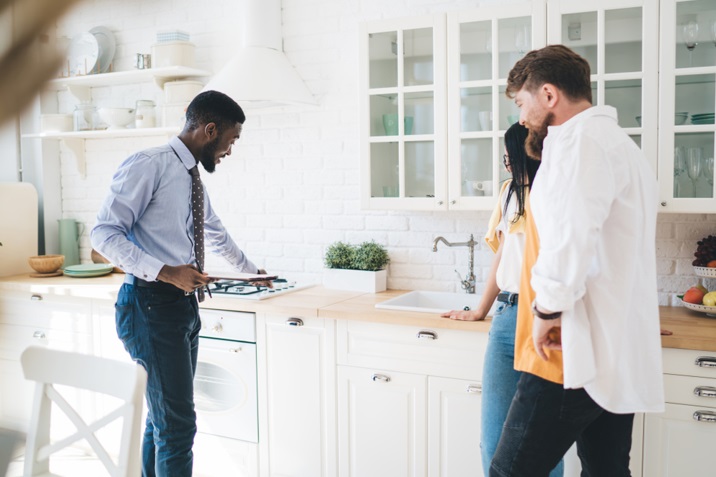What to Look for During a Home Tour: A Buyer’s Guide to Seeing Beyond the Staging

When you walk into a home for a tour, it’s easy to get swept away by the fresh paint, stylish furniture, and maybe even the smell of cookies baking in the oven. But a home tour isn’t just about falling in love with a space — it’s about making a smart investment. That means knowing what to look for beyond what’s on the surface.
Whether you’re a first-time homebuyer or a seasoned mover, this guide will walk you through what to watch out for during a home tour, so you can make a confident, informed decision.
1. First Impressions Matter — But Don’t Stop There
The curb appeal of a home is important. A well-maintained exterior often reflects pride of ownership, which can be a good sign. When you first pull up, take a moment to note:
- Condition of the roof (missing shingles, sagging)
- Driveway and walkway cracks
- Gutter drainage and signs of water pooling
- Exterior paint or siding wear
- Lawn and landscaping upkeep.
A clean, tidy exterior doesn’t guarantee the inside is flawless, but it sets a tone. Still, don’t let great curb appeal distract you from what’s inside.
2. Smells Tell a Story
As soon as you walk in the door, take a deep breath — and pay attention. Does the home smell musty? Overly scented with air fresheners? Smells can indicate underlying problems:
- Musty or damp smells may signal mold, mildew, or water damage.
- Heavy air freshener use could be masking odors from pets, smoking, or mildew.
- Gas or chemical smells should be flagged immediately and reported.
Trust your nose. If something smells off, ask questions or schedule an inspection.
3. Look Beyond the Staging
Sellers often stage homes to highlight their best features — and that’s not a bad thing. But remember: the furniture won’t be there when you move in. Focus on the structure, not the stuff. Ask yourself:
- Is the room size sufficient when empty?
- Are there awkward layouts being disguised by creative furniture placement?
- Are there areas being blocked off that you can’t access?
Take pictures or notes to help you imagine your own furniture in the space.
4. Check the Floors — and What’s Underfoot
Floors can tell you much about how well a home has been maintained. As you walk through each room, notice:
- Are the floors level, or do they feel uneven?
- Are there soft spots that could suggest rot or subfloor issues?
Is there visible warping, buckling, or cracked tiles? - Do the carpets have stains or odors?
Uneven floors might indicate foundation issues, which can be costly to fix. Don’t ignore them.
5. Inspect Walls, Ceilings, and Windows
Take your time scanning the walls and ceilings in each room. Look for:
- Cracks — especially large, jagged ones which could signal structural movement
- Water stains — usually brownish spots on ceilings or walls from leaks
- Bubbling paint — can mean moisture trapped underneath
- Drafty or foggy windows — may need replacement.
Run your hand along the windowsills and check for softness or water damage. Also, make sure every room has adequate windows for light and ventilation.
6. Test Fixtures and Systems (Within Reason)
It’s totally acceptable to test out some of the home’s systems during a tour. Flip switches. Turn on faucets. Open and close doors. Here’s a quick checklist:
- Lights — Do they turn on quickly? Any flickering?
- Water pressure — Try bathroom and kitchen faucets, flush toilets
- Cabinet doors and drawers — Do they open and close smoothly?
Windows — Open a few to see if they slide easily and lock properly - Closet doors — Make sure they aren’t sticking or off-track.
While you won’t be doing a full inspection yourself, these basic checks can reveal red flags.
7. Evaluate Storage Space
Storage is one of those things you don’t fully appreciate until you don’t have it. Take stock of:
- Closet size in each bedroom
- Hall closets or linen closets
Kitchen cabinets and pantry space - Laundry room storage (if applicable)
- Garage or attic space.
Make sure the home fits your storage needs for now and in the future.
8. Don’t Forget the Kitchen and Bathrooms
These are the most expensive rooms to renovate, so you’ll want to evaluate them closely. In the kitchen, look at:
- Cabinet condition (inside and out)
- Countertops for damage or stains
- Appliances — age, condition, and whether they stay
- Ventilation (especially over the stove).
In bathrooms, inspect:
- Caulking and grout for mold or wear
- Water pressure in the shower
- Toilet functionality
- Vent fans or windows for moisture control.
If these rooms look like they need a major overhaul, factor that into your offer.
9. Listen to the Neighborhood
Before or after the tour, step outside and just listen. Neighborhood noise can dramatically affect your quality of life. Can you hear:
- Loud traffic or trains?
- Barking dogs?
- Airplanes overhead?
- Nearby construction?
Also, note how close the neighbors are, how much privacy you have, and whether the area feels safe and walkable.
10. Don’t Rush — Take Notes and Ask Questions
A home tour isn’t a race. Take your time, especially if it’s a property you’re seriously considering. Bring a checklist or take notes on your phone. Ask the listing agent:
- How old is the roof, HVAC system, and water heater?
- Have there been any recent renovations or repairs?
- Are there warranties that transfer with the sale?
- What are the average utility costs?
- Have there ever been issues with flooding, pests, or foundations?
The more information you gather now, the fewer surprises you’ll have later.
Bonus Tip: Book a Second Showing
If you really like a house, schedule a second tour at a different time of day. Lighting, neighborhood activity, and even street parking can change dramatically from morning to evening. A second look can offer a clearer picture — and help you fall in love with the right home for the right reasons.
Final Thoughts
Touring a home is about more than visual appeal. It’s your opportunity to assess the property’s true condition and value. While a good home inspector will dig deeper later, your own observations during the tour can help you avoid costly mistakes and zero in on the perfect home for your needs.
So slow down. Look closely. Ask questions. And when you’re ready to take the next step, DSLD Mortgage is here to help with smart, flexible financing options that fit your budget and your dreams.















